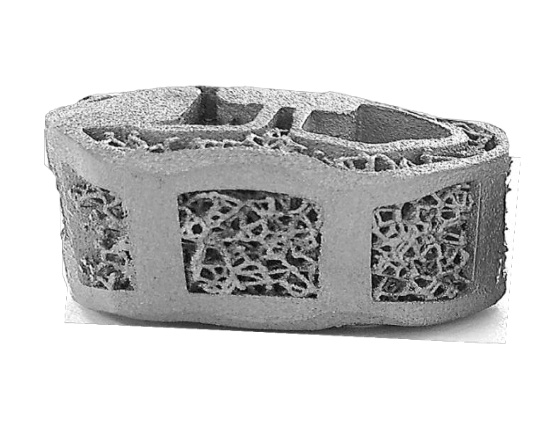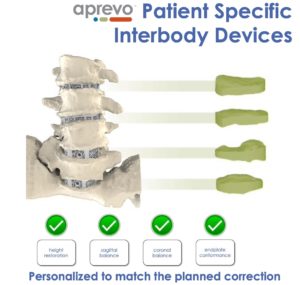
The aprevo® implant, the only spine surgery device to receive the Breakthrough Device designation from the U.S. Food and Drug Administration (FDA), is now being offered at UVA Health. One of the lead surgeons working to foster its development, Justin Smith, MD, Director of the UVA Neurosurgery Spine Division and co-director of the UVA Spine Center, recently introduced the technology, making UVA the first hospital in the eastern U.S. to use this transformative technology.
“Device companies benefit from having surgeon involvement because we know the specific challenges we face, and we can bring those problems to the developers so they can create products to address those issues,” says Smith. “The small group of surgeons chosen for this project are heavily involved in research in spinal deformity and complex spine surgery, and they have very busy practices treating this patient population.”
The breakthrough device designation from the FDA is a testament that this team was right on target in their pursuit to have a more effective tool to treat spinal deformity. “The FDA designation means that this technology is so critical to get to the patient population and has such great potential for improving the current standard of care, that it was fast-tracked to market,” says Smith. “Congress authorized the FDA to create this program exactly for this purpose: so that technologies such as aprevo could be made available to patients sooner.”
What Is aprevo?
The aprevo is a personalized fusion implant that is manufactured on demand to precisely match the specific needs of each individual patient. Using advanced technology unavailable just a decade ago, the manufacturer plans, designs and builds a unique device every time.
“A one-size-fits-all implant was good for the past, but our goal is to continually improve these surgeries and outcomes. Having personalized implants will help us to better achieve the desired deformity correction as well as support the healing and fusion of bones over time,” says Smith.
“The implants we use currently are flat on the ends, but bones aren’t always flat. There are unique contours or shapes to the endplates of each bone, especially in patients with spinal deformity such as scoliosis. In these cases, the ends of the bones can be really distorted,” Smith adds.
“Using a patient-specific implant that conforms to the space exactly can facilitate correction of the deformity and better allow the bones to connect and knit together, which is a big part of the healing process.”
How It’s Made
A multi-slice CT scan of the patient’s spine provides a map for the manufacturer to follow, whether the goal is to fill the space between bones or correct a deformity. “There is some art to it, especially when we want to realign the spine,” says Smith. “Working together, the company and surgeon can adjust the surgical plan to determine precisely how each bone in the spine should be aligned to achieve the desired outcome. Then the company designs the implant to fit that new space between the bones.”
Once the design is finalized, the implant is built using 3D titanium printing technology. It is then sterilized and shipped to the hospital. The total turnaround time: approximately four weeks.
“As the company gets more experienced, the turnaround time will be around two weeks,” says Smith. “This is progressively improving technology, so the more that’s done, the better it gets,” says Smith. “The company will also be able to use its machine learning technology to anticipate my preferred surgical plan in addition to providing the implant design that is going to work best for each patient. We’re very good at this now, but we’ll only get better in the future as more and more implants are made.”
Best Candidates for aprevo
If a surgeon determines that surgery is the best option to treat a patient’s condition, they may be given the option to receive the aprevo implant if they:
- Have a spinal deformity like scoliosis, degenerative disease or abnormal alignment of the spine
- Require a spinal fusion in the lower levels of the lumbar spine
The lower lumbar spine is one of the more challenging areas of the spine to fuse. “The lower lumbar spine is often slow to heal because of added stress on that part of the spine. With a personalized implant, we can put it in better contact with the end plates of the adjacent bones and distribute that stress across the entire bony endplates,” says Smith. “Technically, aprevo can be used throughout the lumbar spine, but I find it especially useful in those cases where we need support between lumbar 4 and 5 and 5 and the sacrum at the base of the spine.”
Push to Personalize Treatments
The aprevo device is one more example of UVA’s commitment to advancing personalized care, which is critically important to Smith and to his patients. “When patients need surgical care, we try to provide them with surgery that is going to improve their symptoms, correct deformities and have a good, long-term outcome and durability so that we can reduce the chance of needing more surgery down the road. I think these personalized implants are a big step toward that.”
Official durability data is not yet available for aprevo. However, based on the literature currently available, Smith says he’s confident personalized implants like aprevo will prove to be a game-changer.
“There are biomechanical studies and lots of literature out there that supports that a personalized implant should provide better fusion rates and better stability,” says Smith. “The device company is supporting research to demonstrate these outcomes, and I think we’ll see these positive results in the years ahead.”
To refer a patient to the UVA Spine Center, call UVA Physician Direct at 800.552.3723.
To learn more about aprevo, contact Dr. Smith via our Physician Relations team. Email LMN2N@virginia.edu or call 434.981.1023.
